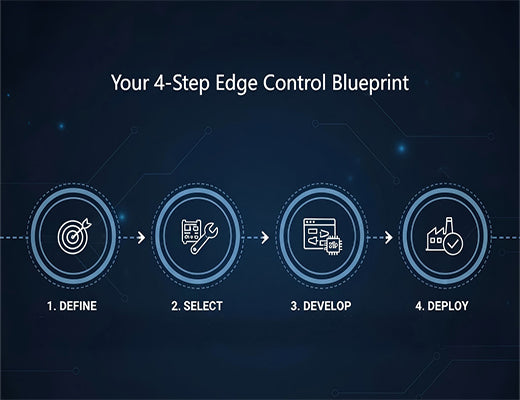
A 4-Step Blueprint for Your First Edge Control Project
|
|
Time to read 5 min
|
|
Time to read 5 min
This guide provides a practical, 4-step blueprint for planning and executing your first edge control project. We'll walk you through the essential stages of a successful proof-of-concept (PoC), from defining a high-impact business problem and selecting the right hardware, to developing and deploying your first "sense-decide-act" loop. Following this structured approach is the key to minimizing risk, demonstrating value quickly, and building a solid foundation for a scalable edge control strategy.
A successful edge control project starts with a small, well-defined, high-impact business problem, not with the technology.
The four key steps are: 1. Define the Problem, 2. Select the Platform, 3. Develop the Logic, and 4. Deploy and Measure.
For a first project, choosing an integrated hardware and software platform (like an Edge Gateway with an open OS) is crucial to accelerate development and reduce complexity.
The goal of a first project is not a perfect, full-scale deployment; it's a successful Proof-of-Concept (PoC) that clearly demonstrates the ROI and validates the approach.
You've read the whitepapers. You understand the theory. You are convinced that edge control can revolutionize your operations. Now, you stand at the edge of a new frontier, and the first step can feel the most daunting. How do you go from a powerful idea to a working, value-generating project on your factory floor?
Let's be clear: a successful first project is not about boiling the ocean. It's about a small, focused, and decisive win. It's about following a proven blueprint. This guide will give you that blueprint.

Before you even think about hardware or software, the most critical step is to define the problem you're trying to solve. The best first projects are not massive, complex overhauls. They are laser-focused on a single, high-impact pain point. Ask yourself:
Choose ONE of these. That is the target for your first edge control project. For example: "We will build a system to automatically detect and reject cracked widgets on Conveyor Belt #4."
This is the on-paper design phase. For your chosen problem, map out the three parts of the control loop:
The 'aha!' moment for many first-time project managers is realizing that an integrated platform is the fastest path to success. You need a single device that can handle all three parts of your loop. This is where an industrial edge gateway comes in.
A platform like the Robustel EG5120 is ideal for this, as it integrates all these components. For a rapid start, an IIoT Edge Starter Kit that bundles the gateway with sensors can be the perfect choice.
This is where you write the "DECIDE" part of your loop. Thanks to modern open platforms, you have options:
Deploy your gateway and container to the machine on the factory floor. The goal of this Proof-of-Concept is to collect data and prove the business case. Track the key metrics you defined at the start:
This measurable result is the "ammunition" you need to justify a wider, full-scale rollout.

Your first edge control project doesn't have to be a daunting, multi-year odyssey. By following a structured, 4-step blueprint—starting with a focused problem, selecting an integrated platform, developing with modern tools, and measuring your results—you can move from concept to a value-generating reality in a matter of weeks, not years. This first successful PoC is the most powerful catalyst for driving a true digital transformation within your organization.
Further Reading:
What is Edge Control? The Future of Real-Time Industrial AutomationDeveloping an Edge Control Application with Docker on the EG5120Calculating the ROI of an Edge Control System: A Guide for Managers
A1: A well-defined Proof-of-Concept (PoC) should aim for a rapid timeline to demonstrate value quickly. Using an integrated platform like a starter kit, a small, focused team should be able to go from unboxing the hardware to seeing the first results in 4 to 6 weeks.
A2: Not necessarily for a first project. The beauty of an open platform is flexibility. You can start with simpler, non-AI logic developed in a low-code tool like Node-RED. For AI, you can leverage third-party AI models or consultants for the initial PoC, while your in-house team focuses on the integration.
A3: The biggest mistake is making the scope too big. Trying to "boil the ocean" by connecting an entire factory at once is a recipe for failure. The key is to pick one small, painful, and measurable problem, solve it completely, and use that success to build momentum and internal expertise for the next project.